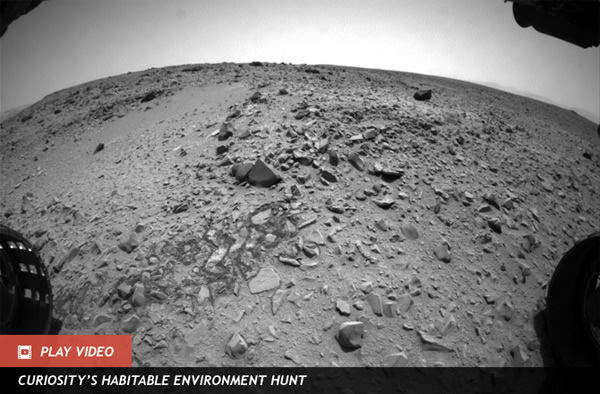And She's Off! Curiosity Hits the Martian Road
And She's Off! Curiosity Hits the Martian Road
It seems that we’ve been waiting a lifetime for NASA’s Mars rover Curiosity to do some serious roving, but the day has finally come. On Friday, mission managers commanded the six-wheeled robot to start its long trek to Aeolis Mons, nicknamed Mount Sharp, the 3.4 mile (5.5 kilometer) high peak in the center of Gale Crater. By NASA’s reckoning, it should take Curiosity between 9 months to a year to reach the mountain’s base.
On Friday (July 5), Curiosity rolled 18 meters. On Monday (July 8), the rover took a longer haul across the rock regolith, clearing 40 meters. In total, since landing on Aug. 5, 2012, Curiosity has roved 915 meters (see this handy Curiosity drive log to keep up with the mission’s odometry). Curiosity has some serious roving to do before it catches up with Mars Exploration Rover Opportunity’s near-marathon run of a little over 22 miles, however. But Opportunity did have a 10-year head start.
For the past 7 months, Curiosity has been investigating a geologically interesting area known as “Yellowknife Bay.” Having only been on the Martian surface for less than a year, Curiosity has already made some landmark discoveries. Yellowknife rocks have given up some fascinating science, providing compelling evidence in their mineralogy that they were formed in liquid water. Through photographic evidence, Curiosity supported this finding by spying obvious layering in the sedimentary rocks. In short, Curiosity has been exploring an ancient river bed. Just in case you didn’t think that was awesome first time around, I’ll emphasize: A river bed. On Mars.
Surrounded by this fascinating geology, NASA decided to keep the rover where it was, delaying its long trundle to Mount Sharp. The rover has been also showing off some mean geologist skills — using its laser to burn holes in rocks, and analyze the spectrum of the vapor it produces; drill holes deep into rock samples; and use its sample scoop to drop Mars material into its onboard laboratory. In short, Curiosity is proving that it’s the best geologist for tens of millions of miles.
Scientists are betting on Mount Sharp as being a scientific “open book” into the Mars’ past, hopefully providing a huge amount of information about the past habitability of the now very dry planet.
Now its long march has begun, but that’s not to say scientists won’t command Curiosity to analyze more interesting geological features along the way.
Image: On the road: Curiosity snapped this photo of a new landscape on sol 327 (July 8) of the mission through its front Hazcam. Credit: NASA/JPL-Caltech(Jul 8, 2013 05:45 PM ET // by Ian O'Neill)












